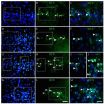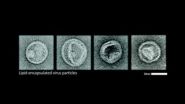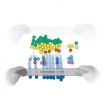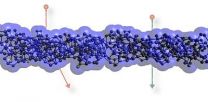(Press-News.org) Half of all patients diagnosed with non-small cell lung cancer are 70 years of age or older, yet despite this high percentage, these elderly patients are not well represented in clinical trials. Therefore, the paucity of clinical data has made it difficult to reach evidence based clinical recommendations.
In 2010, the EORTC Cancer in the Elderly Task Force and Lung Cancer Group along with the International Society for Geriatric Oncology (SIOG) wrote an expert opinion on managing treatment for elderly patients with non-small cell lung cancer (NSCLC), and now, in an article appearing in the Annals of Oncology, they have updated their expert opinion. This update includes recommendations for screening, surgery, adjuvant chemotherapy and radiotherapy, treatment of locally advanced and metastatic disease as well as new data on patient preferences and geriatric assessment.
Dr. Mary O`Brien, Royal Marsden Hospital, UK, and Chair of the EORTC Lung Cancer Group advises, "Treatment decisions for elderly patients with NSCLC should not be based on their chronological age alone; there are many other factors that need to be considered. For instance, what is the patient's life expectancy and preferences? What are the expected benefits and risks of the treatment?"
Dr. Ulrich Wedding, Universitaetsklinikum, Jena, Germany, Chair of the SIOG Publications Committee, and Treasurer of the EORTC Cancer in the Elderly Task Force adds, "People do not all age the same, so we also need to consider their biological or functional age when deciding on treatment. Multidimensional, multidisciplinary, comprehensive geriatric assessment can lead to better treatment for elderly patients with NSCLC."
Several prospective clinical studies concerning both locally advanced and metastatic disease lend support to the feasibility of age-specific clinical trials and provide reliable data, as well, that can be used to guide treatment decisions. The EORTC and SIOG researchers advocate that more effort should be made to develop such studies in other disease stages, and efforts should also be made to include patients more representative of the general elderly population, not just very fit patients.
INFORMATION: END
EORTC and SIOG update expert opinion on management of elderly patients with NSCLC
2014-04-22
ELSE PRESS RELEASES FROM THIS DATE:
US medical innovation needs smarter incentives to cut health spending, study finds
2014-04-22
To help rein in massive health care spending, a new RAND study concludes that U.S. policy makers should urgently find ways to incentivize pharmaceutical companies and device makers to develop products that produce more value.
Instead of examining existing medical technologies and their use, a new study suggests the study identifies options to affect what drugs and medical devices get created in the first place. The aim is to help reduce health care spending with as little loss of health as possible and to ensure that costlier advances have large enough health benefits ...
NREL unlocking secrets of new solar material
2014-04-22
A new solar material that has the same crystal structure as a mineral first found in the Ural Mountains in 1839 is shooting up the efficiency charts faster than almost anything researchers have seen before—and it is generating optimism that a less expensive way of using sunlight to generate electricity may be in our planet's future.
Researchers at the Energy Department's National Renewable Energy Laboratory (NREL) are analyzing the new material, perovskite, using the lab's unique testing capabilities and broad spectrum of expertise to uncover the secrets and potential ...
Commonly available blood-pressure medication prevents epilepsy after severe brain injury
2014-04-22
Between 10 and 20 percent of all cases of epilepsy result from severe head injury, but a new drug promises to prevent post-traumatic seizures and may forestall further brain damage caused by seizures in those who already have epilepsy.
A team of researchers from the University of California, Berkeley, Ben-Gurion University in Israel and Charité-University Medicine in Germany reports in the current issue of the journal Annals of Neurology that a commonly used hypertension drug prevents a majority of cases of post-traumatic epilepsy in a rodent model of the disease. If ...
Short-term environmental enrichment exposure induces maturity of newborn neurons
2014-04-22
Many studies have shown that exposure to environmental enrichment can induce neurogenesis of the hippocampal region, thus improving learning and memory. Previous studies have demonstrated that doublecortin-positive immature neurons exist predominantly in the superficial layer of the cerebral cortex of adult mammals such as guinea pigs, and these neurons exhibit very weak properties of self-proliferation during adulthood under physiological conditions. Whether environmental enrichment has an impact on the proliferation and maturation of these immature neurons in the prefrontal ...
Like a hall of mirrors, nanostructures trap photons inside ultrathin solar cells
2014-04-22
In the quest to make sun power more competitive, researchers are designing ultrathin solar cells that cut material costs. At the same time they're keeping these thin cells efficient by sculpting their surfaces with photovoltaic nanostructures that behave like a molecular hall of mirrors.
"We want to make sure light spends more quality time inside a solar cell," said Mark Brongersma, a professor of materials science and engineering at Stanford and co-author of a review article in Nature Materials.
Brongersma and two Stanford colleagues -- associate professor of materials ...
Grasp of SQUIDs dynamics facilitates eavesdropping
2014-04-22
Theoretical physicists are currently exploring the dynamics of a very unusual kind of device called a SQUID. This Superconducting Quantum Interference Device is a highly sensitive magnetometer used to measure extremely subtle magnetic fields. It is made of two thin regions of insulating material that separate two superconductors – referred to as Josephson junctions – placed in parallel into a ring of superconducting material. In a study published in EPJ B, US scientists have focused on finding an analytical approximation to the theoretical equations that govern the dynamics ...
Cloaked DNA nanodevices survive pilot mission
2014-04-22
VIDEO:
Wyss Institute Core Faculty member William Shih and Technology Development Fellow Steven Perrault explain why DNA nanodevices need protection inside the body and how a virus-inspired strategy helps protect them....
Click here for more information.
It's a familiar trope in science fiction: In enemy territory, activate your cloaking device. And real-world viruses use similar tactics to make themselves invisible to the immune system. Now scientists at Harvard's Wyss Institute ...
Carnegie Mellon system lets iPad users explore data with their fingers
2014-04-22
PITTSBURGH—Spreadsheets may have been the original killer app for personal computers, but data tables don't play to the strengths of multi-touch devices such as tablets. So researchers at Carnegie Mellon University have developed a visualization approach that allows people to explore complex data with their fingers.
Called Kinetica, this proof-of-concept system for the Apple iPad converts tabular data, such as Excel spreadsheets, so that data points appear as colored spheres on the touchscreen. People can directly manipulate this data, using natural gestures to sort, ...
Child's autism risk accelerates with mother's age over 30
2014-04-22
PHILADELPHIA (April 22, 2014) – Older parents are more likely to have a child who develops an autism spectrum disorder (ASD) than are younger parents. A recent study from researchers from the Drexel University School of Public Health in Philadelphia and Karolinska Institute in Sweden provides more insight into how the risk associated with parental age varies between mothers' and fathers' ages, and found that the risk of having a child with both ASD and intellectual disability is larger for older parents.
In the study, published in the February 2014 issue of the International ...
Nanomaterial outsmarts ions
2014-04-22
Ions are an essential tool in chip manufacturing, but these electrically charged atoms can also be used to produce nano-sieves with homogeneously distributed pores. A particularly large number of electrons, however, must be removed from the atoms for this purpose. Such highly charged ions either lose a surprisingly large amount of energy or almost no energy at all as they pass through a membrane that measures merely one nanometer in thickness. Researchers from the Helmholtz-Zentrum Dresden-Rossendorf (HZDR) and Vienna University of Technology (TU Wien) report in the scientific ...





